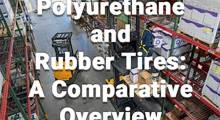In the material handling business original equipment manufacturers, lift truck dealers and distributors find themselves marketing polyurethane and rubber tires simultaneously. To achieve optimum performance one needs to better understand the attributes of each product. In this article, both products will be broadly compared along with their proper application, with an emphasis on polyurethane tires. Some of the areas that will be discussed are:
- Rolling Resistance
- Cushioning
- Traction
- Load Capacity
- Wear and Abrasion Resistance
- Cutting / Tearing / Chunking
- High Speed Operation
- Floor Marking
- Wet Floor Conditions
- Chemical Resistance
- Price
- Attribute Chart
A Brief History of Rubber and Polyurethane
Rubber has been used in tires for over 100 years. Polyurethanes have been used extensively for only 50 years. Since that time rubber and polyurethane have evolved into a highly specialized group of compounds. Polyurethanes were discovered in Germany during WWII while scientists
searched for a synthetic rubber compound. The availability of natural rubber was becoming scarce for Germany as the Americans were putting pressure on their supply lines. As a result, Germany looked for a solution to this problem. It was during their efforts to find a synthetic rubber that the German scientist, Otto Bayer, discovered a material called polyurethane that would later become the workhorse of the material handling industry.
To better understand each material, one needs to understand that rubber and polyurethane tires each have strengths and weaknesses specific to their unique properties. As a general rule, rubber tires are used more extensively on propane and internal combustion types of lift trucks. These trucks often operate both inside and out. In that type of application, rubber is preferred for a softer ride and better traction.
Conversely, polyurethane is limited to electric lift trucks of various types that are used primarily indoors where the floors are made of smooth concrete. Because the load capacity of polyurethane greatly exceeds that of rubber, it is preferred in this application.
Download the Whitepaper to learn more in depth comparisons in each area to help you better pick the tires you want for your forklift fleet.
Article topics
Learn More











